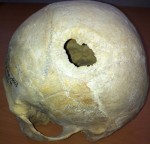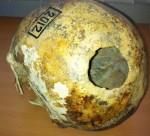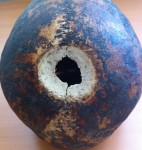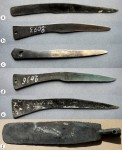A multi-disciplinary team of scientists at the Institute of Archaeology and Ethnography, part of the Russian Academy of Science’s Siberian branch, have recreated the ancient trepanation technique of the nomadic people who inhabited the Altai region of western Siberia between the 6th and early 2nd centuries B.C. A neurosurgeon, a radiologist, anthropologists and archaeologists examined three skulls with antemortem trepanation holes excavated from grave mounds in the Altai mountains and then attempted to perform comparable surgeries using a period-accurate tool on a modern cadaver’s skull.
 All three skulls were unearthed from humble graves. The grave goods and associated burial rites indicate the interred were of relatively low social status, which means at least some of the poorer Altai nomads had access to quite high level health care. The types of graves and funerary rituals are all different, suggesting the subjects came from diverse cultural groups. One of the skulls was excavated from mound three at the Bikeh III burial ground. It belonged to a male between 50 and 60 years old and dates to the 5th–4th centuries B.C. A second skull, excavated from a cyst grave in Kyzyl-Dzhar IV mound two, is that of a woman who died at around 30 years of age. The last is from an undercut, timber-frame grave in Kyzyl Dzhar V mound three and is the skull of a man aged 40-45. Both date to around the 4th-3rd centuries B.C.
All three skulls were unearthed from humble graves. The grave goods and associated burial rites indicate the interred were of relatively low social status, which means at least some of the poorer Altai nomads had access to quite high level health care. The types of graves and funerary rituals are all different, suggesting the subjects came from diverse cultural groups. One of the skulls was excavated from mound three at the Bikeh III burial ground. It belonged to a male between 50 and 60 years old and dates to the 5th–4th centuries B.C. A second skull, excavated from a cyst grave in Kyzyl-Dzhar IV mound two, is that of a woman who died at around 30 years of age. The last is from an undercut, timber-frame grave in Kyzyl Dzhar V mound three and is the skull of a man aged 40-45. Both date to around the 4th-3rd centuries B.C.
Using multi-slice computer tomography scans, researchers first examined the skulls in minute detail to identify any damage or defect that led to the surgeries and to analyze the methods and tools used by the ancient surgeons.
T he skull of the 50-60 y.o. male showed no visible evidence of head trauma, but rather that he suffered from a congenital skull deformation — a flattening of part of the occipital bone caused by an improper closing of the lambdoid suture. This was not a dangerous or painful condition at this point in his life and there’s no sign of trauma or tumors, so it’s not obvious why surgical intervention was attempted. Whatever was ailing him, it didn’t leave tell-tale signs on the cranium. The skull of the woman bears evidence of severe trauma: fractures in the right temporal bone and at the base of the middle cranial fossa, possibly caused by a fall from a height. The skull of the 40-year-old man indicates he suffered significant head trauma causing damage to his left temporal and parietal bones. That injury resulted in a hematoma — bleeding in the brain that forms a clot — which would have inflicted a variety of painful symptoms including headaches, vomiting and difficulty moving his right limbs.
he skull of the 50-60 y.o. male showed no visible evidence of head trauma, but rather that he suffered from a congenital skull deformation — a flattening of part of the occipital bone caused by an improper closing of the lambdoid suture. This was not a dangerous or painful condition at this point in his life and there’s no sign of trauma or tumors, so it’s not obvious why surgical intervention was attempted. Whatever was ailing him, it didn’t leave tell-tale signs on the cranium. The skull of the woman bears evidence of severe trauma: fractures in the right temporal bone and at the base of the middle cranial fossa, possibly caused by a fall from a height. The skull of the 40-year-old man indicates he suffered significant head trauma causing damage to his left temporal and parietal bones. That injury resulted in a hematoma — bleeding in the brain that forms a clot — which would have inflicted a variety of painful symptoms including headaches, vomiting and difficulty moving his right limbs.
Both men had pieces of their left parietal bone removed. The older gentleman’s skull has a semi-oval hole that is 45 by 52 mm (1.8 by 2 inches) at the outer perimeter with an inner hole of 22 by 34 mm (.87 by 1.34 inches). The younger fellow’s skull has a round hole that is 63 mm by 64 mm (2.5 inches) on the outside, 40 mm by 41 mm (1.6 inches) on the inside. The young woman’s skull has an irregular round trepanation hole in the back of the parietal bones centered on the sagittal suture. It’s 39 mm by 36 mm (1.5 by 1.4 inches) on the outside, 23 mm by 16 mm (.9 by .6 inches) on the inside. The inner and outer measurements are a result of a two-stage process: first a larger surface layer of bone was cut out with a sharp tool leaving a thin layer of skull, then a hole was cut into the thinned out bone with short, frequent movements.
 The men’s skulls both have extensive bone regrowth at the surgical sites, which means they survived and went on to live for years after the operation. The woman was not so lucky. She died either during surgery or right after it, and little wonder since her surgeon did an atrocious job. The surgeons who operated on the men cut holes that were just large enough to address the problem (remove the hematoma from the younger man; possibly remove parasites from the older one) and at a safe distance from the sagittal sinus, into which all the major veins from the top of the skull open. The woman’s trepanation hole is right above the superior sagittal sinus, so it’s a fair assumption that she died from massive bleeding.
The men’s skulls both have extensive bone regrowth at the surgical sites, which means they survived and went on to live for years after the operation. The woman was not so lucky. She died either during surgery or right after it, and little wonder since her surgeon did an atrocious job. The surgeons who operated on the men cut holes that were just large enough to address the problem (remove the hematoma from the younger man; possibly remove parasites from the older one) and at a safe distance from the sagittal sinus, into which all the major veins from the top of the skull open. The woman’s trepanation hole is right above the superior sagittal sinus, so it’s a fair assumption that she died from massive bleeding.
The two successful surgeries were performed with distinct finesse by knowledgable surgeons. They may have developed this knowledge independently, perhaps developed from expertise in embalming, from the fast and thorough butchering of stock and game that a nomadic existence requires, or from making objects out of animal bone, a craft that was extensively practiced by the Altai nomads in the 5th century. There’s also a chance they may have had contact with western medical practices during war, trade or travel. Hippocrates wrote the treatise On Head Injuries in the 5th or early 4th century B.C. which specifically addressed the importance of avoiding the blood geyser areas of the brain when digging holes into the skull.
 Since even with today’s technology scraping or cutting or grinding bone leaves particles from the tool on the bone, the team tested the new bone growth on the two men who survived the operation for material that would identify which kind of tool was used. X-ray fluorescence and mass-spectrometric analyses discovered particles of copper and tin, which means the skulls were cut with a bronze instrument. The lack of arsenic further narrows it down to stannic bronze which at the time of the burials was being used in the Minusinsk Basin. The Martyanov Museum in Minusinsk has a large collection of stannic bronze tools — knives, saws, lancets, tweezers, probes — that archaeologists have posited had a surgical purpose. Unfortunately they were not excavated in context (looters sold them to the museum in the late 19th, early 20th century), so it’s hard to pinpoint a date of manufacture.
Since even with today’s technology scraping or cutting or grinding bone leaves particles from the tool on the bone, the team tested the new bone growth on the two men who survived the operation for material that would identify which kind of tool was used. X-ray fluorescence and mass-spectrometric analyses discovered particles of copper and tin, which means the skulls were cut with a bronze instrument. The lack of arsenic further narrows it down to stannic bronze which at the time of the burials was being used in the Minusinsk Basin. The Martyanov Museum in Minusinsk has a large collection of stannic bronze tools — knives, saws, lancets, tweezers, probes — that archaeologists have posited had a surgical purpose. Unfortunately they were not excavated in context (looters sold them to the museum in the late 19th, early 20th century), so it’s hard to pinpoint a date of manufacture.
 Neurosurgeon Dr. Aleksei Krivoshapkin first tried to use one of the blades from the museum on a skull, but it was too soft and couldn’t get purchase on the bone. Archaeologist Andrei Borodovsky made an experimental knife out of a brass alloy of copper, tin and zinc. That addition of zinc made for a functional skull-cutting tool that the team could test on a cadaver skull.
Neurosurgeon Dr. Aleksei Krivoshapkin first tried to use one of the blades from the museum on a skull, but it was too soft and couldn’t get purchase on the bone. Archaeologist Andrei Borodovsky made an experimental knife out of a brass alloy of copper, tin and zinc. That addition of zinc made for a functional skull-cutting tool that the team could test on a cadaver skull.
 Here’s the most amazing part of this fascinating foray into ancient brain surgery: the operation took 28 minutes. Using a freaking brass knife and Altai cutting techniques, it took Dr. Krivoshapkin less than half an hour to make a two-inch hole in a skull. I was just reading the other day about how Cervantes’ father was a surgeon and it was seen as a low job, akin to a butcher, but look at the incredible skills that butcher heritage brought to the surgical table. I hope Cervantes Sr. was all “Yeah, that’s right. I’m an amazing butcher. You wish you could do with living tissue what I can do in 28 minutes. Haters to the left.”
Here’s the most amazing part of this fascinating foray into ancient brain surgery: the operation took 28 minutes. Using a freaking brass knife and Altai cutting techniques, it took Dr. Krivoshapkin less than half an hour to make a two-inch hole in a skull. I was just reading the other day about how Cervantes’ father was a surgeon and it was seen as a low job, akin to a butcher, but look at the incredible skills that butcher heritage brought to the surgical table. I hope Cervantes Sr. was all “Yeah, that’s right. I’m an amazing butcher. You wish you could do with living tissue what I can do in 28 minutes. Haters to the left.”